Nicole Montag-Keller
This paper reports on what ‘Moon meets Sun and Sun meets Moon’ means to the researcher, noted in a sky journal from end of May till mid July, 2017 at a location in North-Western Switzerland. Qualitative, phenomenological and reflexive research was conducted with a focus on ‘Verstehen’. The methodological approach rendered to exhibit in depth perceptions, thoughts and feelings, showing how factual clarity and intuitive sensations belong to the broad dualities of materiality and spirituality. The research gave way to the understanding of individual identity formation, personal development and self-realisation informed through biography and lived experience. The report offers an expression of a personal cosmology, world-view and attitude by addressing the interrelatedness of a meaning making process: between sky objects, landscape and the researcher at a certain time in a certain place.
Introduction
The aim of this research is what ‘Moon meets Sun and Sun meets Moon’ means to me and how, as a result of the observation of Moon and Sun, I was influenced, affected and shifted in my lived experience. Since my last name is Montag, I feel emotionally connected to the Moon, but I understand that the sky objects moon and sun express also my understanding of materiality. Additionally, the Moon and the Sun hold symbolic meaning for me, which is highlighted in the course of my own path of life, which this report means to be an expression of the developmental changes and transformation I underwent as a consequence of observing and relating to the Moon. I look into how I construct, what Nicolas Campion termed an ‘individual’s worldview or meaning system’, my personal cosmology, and I also assess whether my research confirms what Freya Matthews suggested, that ‘cosmologies may be self-affirming or not and are conditioned by various aspects of the culture in which they develop’.[1] I conducted qualitative, phenomenological and reflexive research, referring to Charlotte Aull Davies, that ‘informed reflexivity is compatible with, indeed is essential for, both a realist ontology and a commitment to social scientific knowledge in the sense of knowledge that is based in, and can inform us about, a real social world and that is public and open to critical analysis.’[2] Using the content of my sky journal entries, I looked to understand how being me, a person at a certain time in history at a certain place on earth and how relating to Moon and Sun shaped my personal experience as well as my world-view. This view is informed by Terry Eagleton’s definitions of nature and culture, where ‘the word culture shifts from the natural to the spiritual’ giving way to the unification of outer and inner worlds for arriving at what Eagleton suggests is ‘self-realisation’, knowing oneself by understanding oneself. [3]
Academic rationale
Since I was born with the last name ‘Montag’, translated as ‘the day of moon’ according to the Oxford Dictionary, the Moon represents my ancestral identity.[4] Next to having an emotional and genetic-material family link, I also refer to the Moon as a material sky object nearest to the Earth, which is put forward by Martin Rees who wrote, that the Moon is ‘1.2% of the Mass of Earth, …, geological activity has long since ceased, so it is a lifeless, dusty, and dead world.’[5] Furthermore the Moon also holds symbolic meaning for me, which is put forward by Hajo Banzhaf (1949-2009), a German astrologer, who attributes to the Moon the heavenly and the earthly mother figure.[6] Additionally I perceive the Moon’s nature as an indicator of time, described by Caryad, Thomas Römer and Vera Zingsem, where exterior life cycles are governed from full moon to full moon, called a sidereal month seen from earth (27.3 days) and a synodic month of 29.5 days in going round the sun.[7] Not only does the Moon indicate time, but is the heavenly body expressing constant change, which has a further impact on inner life cycles such as menstruation and influences on the psyche. As Hajo Banzhaf suggested in his book about the path of life, the Moon’s rhythm throws a shadow on the sun, called sun eclipse, translated into psychological terms that the repressed unconscious traits of a person come to the surface triggered by the Moon’s cyclical nature.[8] In addition to the Moon I also looked into the role of the Sun in astrological-archetypal and psychological terms. The Sun represents the individual which is on a journey to becoming oneself, by uniting the unconscious with the Ego, as described by Banzhaf, referring to Carl-Gustav Jung’s, model of the three stages for becoming Self. [9] Additionally I put forward Erik Erikson’s, psychological model of eight developmental stages in identity development, which need to be experienced in order to develop ‘a stable, consistent and reliable sense of who we are and what we stand for in the world that makes sense for us and for our community’ introduced by Ann Phoenix in a chapter on embodying identities in order to show, that models vary, but that stages of psychic development need to be undertaken.[10] In contrast I could, how Nicolas Campion expressed it, be a follower of ‘utopianism’, ‘the universal impulse to become one’s self, to live one’s unrealized potential’ instead of living in the present without an idealised future.[11]
In summarising I refer to the Moon expressing my emotional, material, psychological and cyclical aspects of my personality and I refer to the Sun as a symbol of a pathway for becoming one with myself, having consciously developed and integrated my shadows into my identity.
Methodology
The primary source in this paper is the Moon and the Sun in the sky, which is observed from my study room. For better understanding of how the hillside appears to me, I refer to a snapshot taken in Google Earth (Figure 1).

As suggested by Sarah Pink, I was using a notebook, called a sky journal, as an auto ethnographic instrument. The research I undertook is qualitative, placing an emphasis on my observations and perception what had happened to my outer and inner worlds.[12] The journaling phase of the project commenced on Thursday, 25th May 2017, a Christian holiday called Ascension Day, and ended 55 days later on Tuesday, 18th July, 2017. I took several pictures with my iPhone camera, and incorporated some pictures taken earlier. I also drew how I saw the Moon and the Sun. These Moon and Sun images capture moments that made an impression on me and unique events such as consciously recognising the morning star Venus for the first time or eye-witnessing the fall of a comet touched me deeply. I will never forget these feelings of joy.
In order to understand how the two sky objects, the Moon and the Sun were observable and what the expression ‘the Moon meets the Sun and the Sun meets the Moon’ meant to me I used reflexive ethnographic research through observation, listening and noting my thoughts, perceptions, feelings and reactions. The chosen methodology bears two issues as Charlotte Aull Davies, author of Reflexive Ethnography, writes ‘that it is self-indulgent and narcissistic, telling us about the ethnographer, not about the social and cultural phenomena that are the proper subject matter of ethnography…’ and that the approach ‘represents a particular Western literary genre, the Great Man tradition, …used to describe individual achievements based on a linear and goal-oriented interpretation of what constitutes a meaningful life.’[13] Aull Davies highlights what could be a serious downside to this research due to my biographical approach, the Sun’s or Hero’s conscious journey towards becoming self. To me, the only resolution of these two issues means that I maintain a constant awareness of my judgemental and self-centredness, both being involved but also detached towards this research as Powdermaker expressed put forward by Aull Davies.[14] Furthermore my primary focus of the research was on Verstehen, that is, I looked into understanding my own perspective, subjectivity, individuality, world-view and cosmology while I was in contact with the research objects, the Moon and the Sun.[15]
Reflexive considerations
I am a white female, in my forties, being home in North-Western Switzerland for more than ten years. I grew up in the Northern part of Baden-Wuerttemberg and moved to the South of Baden-Wurttemberg to pursue third level education and also lived in the nearby Alsace, France. Through the experience of living in different locations and contexts, I express my understanding and awareness of cultural differences.
I studied psychology as an undergraduate degree, because I wanted to understand human behaviour. In the course of these studies, I realised, that I am deeply enmeshed being a co-dependent person. That is, according to Sharon Wegscheider Cruse, a family therapist, I am role-playing ‘The Hero’, meaning that I ‘keep negative feelings to myself, not to make someone angry; express a lot of positive feelings, for winning approval; not talking to outsiders about what happens in the family, because no one would like me, if they knew the truth and because my family affair is just something we don’t talk about’.[16] Through the experience of observing Sun and Moon, I express my understanding of me becoming more myself.
I grew up with a Roman-Catholic faith and though not being a member of any church, I call myself a Christian. In the process of accepting my co-dependency, I learnt to deal with my own pain by addressing a higher spirit.[17] After I moved to North-Western Switzerland, I encountered anthroposophy, a strand of theosophy, which I define as a philosophical framework for the development of spirituality with an emphasis on Christianity. As a consequence I started studying the works of Rudolf Steiner, the founder of anthroposophy. I understand that my Christian belief system and anthroposophical world-view have an effect on how I arrive at meaning in the course of my research.
In concluding I express how my social and cultural surrounding, but also my interest in spirituality shapes my meaning making processes and understanding.
Literature review
The sky journal was my primary source. In order to arrive at meaning and understanding of my simultaneously material and spiritual world-view I drew on Nicolas Campion’s work for how I arrived at my personal cosmology, drew on Freya Mathew’s approach to the ecological self for understanding whether my cosmology self-affirmed or did not self-affirm on how I am shaped by the culture I am part of.[18] The research was informed methodologically by Charlotte Aull Davies, using her approach for doing phenomenological and reflexive ethnography and further focusing my methodological research on Verstehen as suggested by Monique Hennink, Inge Hutter and Ajay Bailey.[19] In constructing my understanding I categorised my research into the broad dualities of materiality and spirituality as put forward by Terry Eagleton. Additionally I referred also to astronomers, astrologers, psychologists and psychoanalysts to inform my research.[20]
Field work and discussion
My sky journal analysis overview (figure 2) revealed 499 entries, which were subdivided into 15 categories. Eighty-five entries (18%) linked to ‘Erkenntnis / insight’. Followed by ‘feeling’ seventy-four times (15%), then sixty-two times (12%) ‘foto/art’ and fifty-seven times (11%) I allocated ‘question’ to my entries. ‘Unique’ was selected fourty-seven times (9%), ‘Dream’ thirty-seven times (7%), closely followed by ‘knowledge or wisdom’ thirty-six times (7%). ‘Sky, Moon, Sun’ were categorised twenty-eight times (6%), followed by ‘Ordnung/structure’ and ‘meditation’, both twenty times (4%). Two percent of my entries were coded with ‘library’, ‘moral/ethic’ and ‘wish’ and one percent were allotted to ‘thankfulness’ and ‘worries’ respectively.
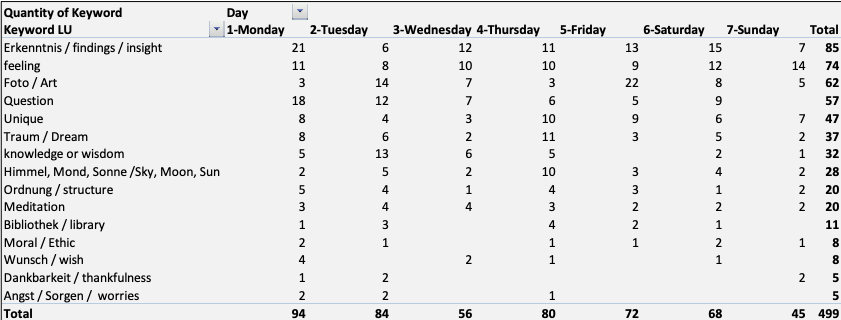

The word cloud depicted in figure 3 exhibits the most frequently used words by depicting them larger than other key words, which are derived from coding my sky journal in order to find my themes (figure 2). It becomes clear, that my main engagement with the sky was first the Moon, then the Sun, followed by the hilltop ‘Gempen’ reference point, having taken photos of the Moon, having referred to the day itself, having mentioned shadow, having written about reflection and shadow.
Moon and clouds and Moon as transformer of repressed feelings
On 7th July 2017 I took pictures of the changing expression of the Moon behind clouds (figure 4a) and sketched how I saw the moon (figure 4b) ending up with a note, that ‘the clouds tell the story – they model shapes which turn to associations in my mind!’(figure 4b). The clouds acted like a cloth and made the Moon become an actor on stage. Much in the same way Alexandra Harris put it, when she described Shakespeare who perceived ‘the mind is a theatre, like the sky, in which whole cities can be built up’ or transforming the Moon to an actor.[21] Moreover for the first time I had written my perception into a drawing, which, on reflecting my experience, might have given way accepting to express my feelings openly for the first time. In retrospect this night represented a turning point in my sky journaling, because on 8th July 2017, at 04:12 a.m. I saw Venus to the East for the first time. I was deeply touched by this encounter and felt a stream of warmth flowing through the upper part of my torso. In the language of the chakra system, I would have termed this an activation of the heart chakra (an invisible energetic vortex over the heart), as put forward by Anodea Judith, being perceived as the energetic centre of the balanced inner female and male Jungian archetypes.[22]
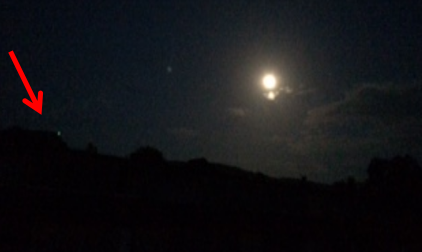
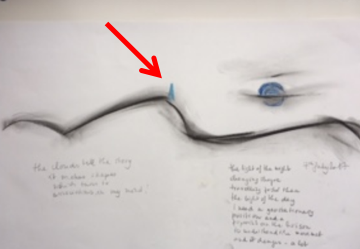
Figure 4a: Nicole Montag-Keller, Photo of the Moon behind clouds on 7th July 2017 at 22:32h, around with red arrow indicating the Gempen, 2017; Figure 4b: Nicole Montag-Keller, Artistic expression of how Nicole Montag-Keller saw the Moon through clouds on 7th July from 22:26-22:36h with red arrow indicating the Gempen, 2017.
The observation of the Moon represented a core focus of my sky journaling exercise and a question coming up repeatedly was, ‘what does the moon reflect?’ as written on 1st, 3rd, 4th and 6th July 2017. Answered from a rational and material point of view, the Moon reflects the Sunlight, but answered from a spiritual point of view, the Moon reflected my feeling of sadness as written on 4thJuly 2017 ‘Sadness is here’.[23] As I have written in my reflexive considerations, expressing negative feelings was a challenge to me, but acknowledging them in this report could point out, that on my journey towards becoming myself, the embracing of this shadow side of my personality is a step on my way trending towards a more united experience of my moon aspect related to the female personality attributes and my sun related male attributes as was put forward by Hajo Banzhaf.[24] Accepting my sadness meant that I could experience an inner healing, as a consequence of embracing this shadow, according to Banzhaf and additionally that I could feel less burdened more in peace with myself.[25]
In summarising my reflections on the expression of my feelings as a consequence of observing the Moon and asking constantly what the moon reflected to me, as well as sketching the moon on paper as I saw it added by a unique encounter of observing the Venus as a morning star, triggered the release of my repressed feelings. Being persistent in asking what the moon reflected and waiting patiently for the answer, made me feel relieved.
Weather as an experience of the sky
My feelings mostly related to the weather, expressed by noting my annoyance with high temperatures and my thankfulness about clouds. I did not expect, that I was affected by weather conditions in the way I expressed them. Figure 5 displays the day and night temperatures throughout my sky journaling project, where +25°C mark the beginning of discomfort and any temperatures higher than +30°C were experienced as distress. Overall, I felt discomforted for 19 days and distressed for 21 days. Commenting on my feelings due to the heat, read like ‘warm-hot’ on 10th June, ‘waking up unmotivated’ on 13th June, ‘hot day’ every consecutive day from 16th till 22nd June, ‘having woken bad tempered, because it is far too hot in the room’ and ‘hot-humid’ on 8th July. On 12th July I wrote ‘the sun builds up so much heat, sedating me, benumbing me, making me angry, because I am slowing down. The heat makes me feel depressed. It is impossible to escape that heat.’[26]
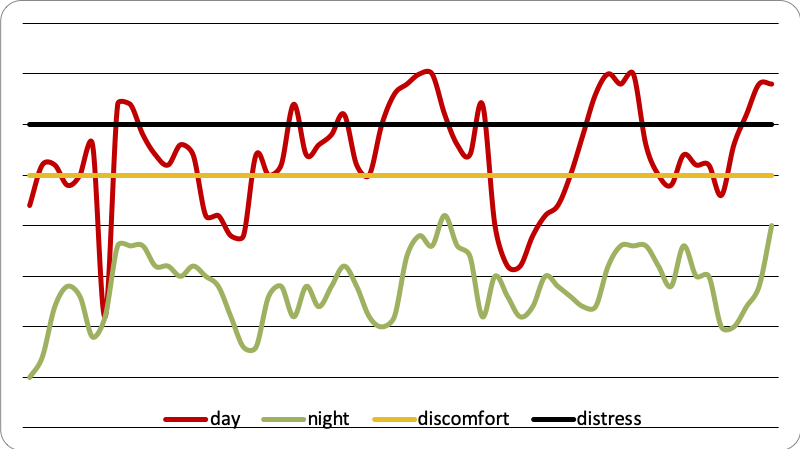
Reflecting upon my experience I agree with Alexandra Harris’s statement written in ‘Weatherland’, that ‘our thoughts will be affected by the kind of weather we’re in.’[27] I felt the sun’s power as much as Crusoe mentioned in Weatherland, who ‘found on his island, that heat went straight to the head and disrupted his work.’[28] On 9th July I noted ‘it started to rain, thank God’ which made me aware that I referred to a supernatural entity, a God, who I felt was in charge of rain, bringing relief from the heat.[29] I developed this thought further and found that I unconsciously might have referred to Jupiter, ‘the highest God of the Greek pantheon’, male ‘emperor over the sky, rain god and cloud baler’ as described by Jean Shinoda Bolen in her book ‘Gods in every man’.[30] And by weaving rain and sun together I thought, that the excessive heat might have exhibited the sun God Apollo’s dark side, nature’s destructive quality ascribed to a sky God ruling over nature, which I found also mentioned in Bolen’s book.[31]Interestingly I did not make an association with Thor, the equivalent of Jupiter in Nordic mythology put forward by Banzhaf in his introduction to Astrology pointing out, that my astronomical-cultural reference system is more tied to Greek-Roman mythology.[32]In the night of 1st June 2017 I noted ‘The thunder which came out of the depths of the evolving weather occurrence was very powerful. That was alive. There was something that was angry.’[33] The experience of comparing my bodily experience with having had an encounter with the Thundergod is a vivid memory, because I was walking inside our home, when a bolt came down the sky and I was actually feeling a sizzling voltage going through my body and in my journal I wrote ‘Thunder night and I was being permeated by the bolt’.[34] With my rational mind, I would argue, that there is no such thing as a God who sends bolts from the sky. Instead I would explain how zones of high and low pressure mix and mingle in the troposphere of the earth.
In summarising my reflections on the weather, I cite Nicolas Campion who put forward, that ‘for pre-modern cultures, the cosmos was interior as much as exterior; it was inside as much as outside us.’[35] My experience with the ongoing high temperatures and feeling as if an angry sky good was sending thunder and bolt towards earth, confirms, that that to me, Sun and Jupiter are not only sky objects, but living entities and that I have a relationship to these rulers of the sky.
Moon as tool for measuring the sky and attributing meaning to a landscape
On 2nd June 2017, while taking pictures of the Moon, I understood, that I needed to stand at exactly the same spot for being able to find differences of the Moon’s pathway in the sky’.[36] Comparing my pictures from March till May (Figures 6a,b,c) and from June till August (Figures 7a,b,c), for the first time I realised, that the Moon’s rising point shifts on the horizon.

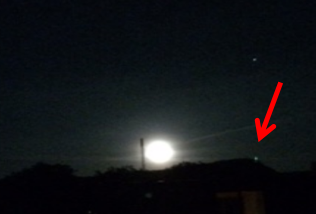
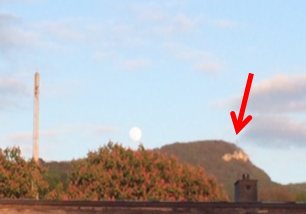
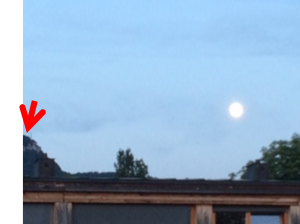
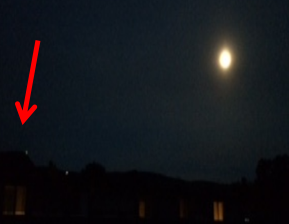
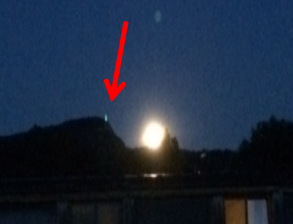
From March till May 2017 the Moon rose to the East of the Gempen in comparison to the months of June till August when the Moon rose South of the Gempen hilltop. Upon discovering this phenomenon, I asked myself whether I had found a pattern, which would put the Gempen hilltop into the centre of my personal cosmology. I was even inclined to promoting the Gempen into a sacred landscape, which is put forward by Edwin Bernbaum in his paper on ‘Sacred mountains: themes and teachings’.[37] Bernbaum writes, that ‘as sacred expressions of some deeper reality, mountains have become associated with the deepest and highest values and aspirations of cultures and traditions throughout the world.’[38] Since I singled out the peak called ‘Gempen’, I felt, that I had found a particular place of tradition and sanctity. Unfortunately I could not source literature about the Gempen hilltop in the University library of Basle, but for future reference I will need to figure out how to access the archive of the Canton’s archaeology department for being able to make any definitive statements about the Gempen. In order to support my personal cosmology of the sacredness of the Gempen a little further, I added a picture from September 2016 (Figure 8).
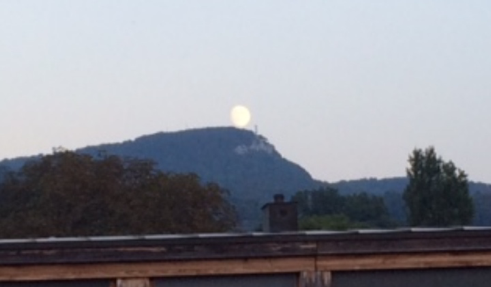
Figure 8 shows, that on 14th September 2016, the Moon rose over the Gempen hilltop, but I abstain from any further conclusions, because as the astronomer Wolfgang Held wrote in his booklet called ‘Sternkalender’ (star calendar), ‘no monthly run of the Moon is similar to the next’.[39]
In summarising my reflections on the Moon as a tool for measuring the sky and attributing meaning to a landscape I plan to stick with my observations in order to better understand where and when the Moon appears in different stages of its phases over the Gempen hill ridge.
The Moon’s pathway in the sky and recurring eclipses
In the night of 7th July 2017 I sketched three moon shadow movements using the window frame (marked by two orange lines) as the reference object (figure 9a). As Calvin wrote, ‘thanks to the fondness towards windows of new-world archaeoastronomers and towards steles of old-world archaeoastronomers…a plane floor can replace the evenly shaped horizon, if the room has a window or door to the East.’ [40] I used a window frame facing East and sketched three open ended shadows lines; by marking the end point on a horizontal plane, I could apply Calvin’s home methodology to my observations, tracing pathways which eventually will lead me to being able forecasting moon eclipses when taking the summer and winter solstice points into account.

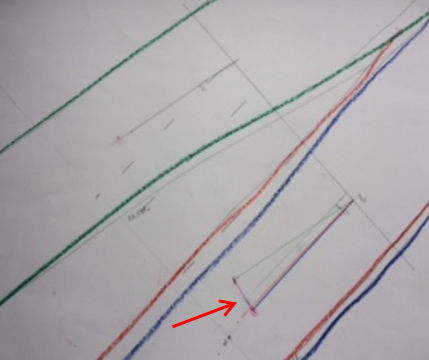
In addition to my earlier mentioned observations, I am inclined to agree with Caryad, Thomas Römer and Vera Zingsem, who wrote in the book ‘Wanderer am Himmel / Planets in the Sky’, that ‘as soon as a group (of people) or community start observing these signs (movement of sun compared to horizon throughout the seasons and the lunar phases) systematically, …, they quickly will observe the cyclical reoccurrence of these sky phenomena and are able to build on these a time measuring system.’[41] I disagree terming this process ‘quickly’, because as William H. Calvin wrote in ‘How the Shaman stole the Moon’, that it takes at least three times 18 years and 11 days, three times a so called ’saros cycle’ in order to predict eclipses. [42] Our prehistoric ancestors, as put forward by Ami Ronnberg in the Book of Symbols, must have feared the extinction of the sun of the light and felt, that demonic powers engulfed the sun when an eclipse occurred.[43] Even today, sun or moon eclipses are making it to the media, such as the solar eclipse of 21st August 2017, being labelled as ‘doomsday’ in the BBC’s internet appearance; see a snapshot in figure 10.[44]
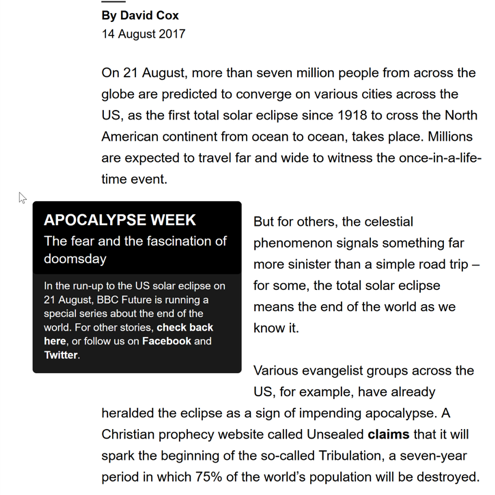
In summarising my reflections on the moon’s pathway in the sky and recurring eclipses, I felt happy, when I was able to apply geometry to my shadow sketches which proved to me, that I was able to re-confirm astronomical knowledge that the moon describes a curved pathway in the sky. Additionally I understood the concept of how to arrive at the prediction of eclipses as put forward in Calvin. I am surprised, that eclipses are still perceived as negative sky events, because to me, these phenomena are occasions to observe a natural phenomena and I feel thankful for living in such a wonderful environment.
Sun addressed spiritually and as an expression of the healing aspect
Though I planned to observe the Sun as regularly as the Moon when proposing my project, I observed the pathway of the Sun in the sky in depth in the course of my student task, where I found out how to predict the time of the day by looking at the shadow’s location outside and inside my home through the location and length of the sun’s shadow. My approach for the sky journal then changed to my daily link with the Sun, while doing silent morning and evening meditations focusing my attention on greeting and thanking the sun (mornings/evenings) ‘for shining, glowing and permeating humanity’ throughout the fifty five days of journaling.[45] This ritual has become a habit and is actually the outcome of studying some of the works of Rudolf Steiner. I felt, that this could be my spiritual contribution towards world peace, because from my point of view donating money represents only a material input. The idea of ‘worshipping’ the Sun in meditation stems from Steiner’s writing on ‘Anthroposophy as Cosmosophy’, that ‘this central spiritual being (Sun) was perceived as one with Christ by older humankind’ which is linked to my Christian belief system.[46] Yet another example of how I related to the Sun can be seen in the photos I took from the sun shining through a tree, producing a colourful reflection (figure 11a) and how the shadow fell on my blank piece of drawing paper while I sat in the garden (figure 11b).

Because the sun’s shadow moved so quickly over the paper, I had to sketch quickly the contour lines resulting in darker straight lines, whereas I imagined the sun rays, dancing in curls over the paper. Finally I added the coloured sun reflection, which I could not see with my eyes, but was detected with 21st century technology. The iPhone camera exhibited how the light was split in its spectral colours.
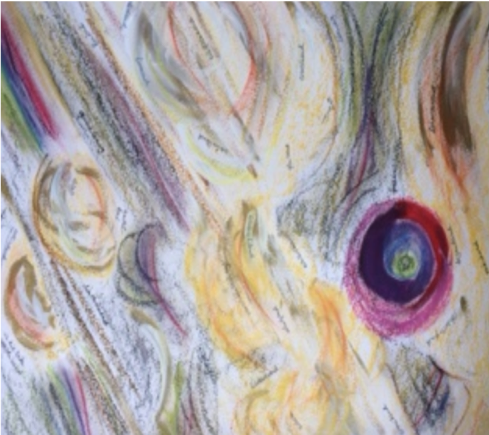
Set of word associations coming to my mind when contemplating on the drawing of the sun rays and the sun’s shadows on 19th July 2017’, 2017:
| Positive: in die Erde versenkend, einströmend, eins, unteilbar, verdichtend, geradlinig, formend, umhüllen, erweckend, lebendig, warm, bezaubernd, verändernd, schwingend, immerfort in BewegungNegative: erblindend, blendend, einbrennen, gleissend, einstrahlend, erhitzend, ermüdendNeutral: farbig, spektralfarbigCreative word: verschmetterlingt |
Figure 12 shows, that I described the sun light with 15 positive words or expressions in comparison to six negative words, further I noted two words referring to colour and invented a word, because a butterfly crossed my path as I was doing this artwork, making me smile. I argue, that light is the source of life, since being exhibited to less or no sunlight, might put human beings into Seasonal Affective Disorder as put forward by Jacob Liberman, who wrote a book about ‘light’ being ‘the medicine of the future’ because light has an influence on the morale of man.[47] This is in line with my experience of excessively high temperatures described earlier but I want to add, that I also experienced the healing power of Sunlight back in the beginnings of 2000, when I went through a period of feeling thoroughly empty.
In summarising my reflections on the Sun which I address daily in a spiritual approach, I understand, that I exhibit New Age behaviour and utopian ideas, as put forward by Nicolas Campion who calls Alice Bailey and Rudolf Steiner ‘New Age Christians’.[48] Furthermore I became aware, that I perceive the Sun as an expression for the power of uplifting and disturbing.
Final thoughts
As a final thought I express my surprise in what I have found to mean that the Moon meets the Sun and the Sun meets the Moon. I am relieved, that I was able to uncover my repressed feelings and I feel as if many presents were given to me, either by encountering Venus or a comet (17th July around 23:00 h facing North) which can signifying something new is coming, as put forward in the book of symbols.[49] Through the analysis of my sky journal I am now aware of how the split between the material and the spiritual runs through the expression of my inner and outer culture and therefore also my identity. I fully agree with Campion, that my cosmos is ‘as inside as much as outside of me.[50] I am satisfied, that I learnt to use the Moon as a tool for measurement and I am still positive towards watching eclipses. I acknowledge, that I address the Sun daily spiritually, expressing an attitude of ‘if it doesn’t help, it won’t harm anyway’.[51] This attitude leaves me to mention Ernest Naylor who wrote in his book ‘Moonstruck’, that ‘we live in an age when the reality of the Moon has been studied intensively’ and that we need to contrast technically derived sky events (moon landing) ‘with perceptions of the Moon (and Sun) by early humans, for whom cyclical changes in the size, shape, and position of the Moon in the sky had mystical properties’, which then ‘were formalized in lunar myths and legends among citizens of societies worldwide as in those of ancient Rome and Greece’.[52] To me mythology signifies a cultural aspect of approaching the sky, as does the material approach.
Conclusion
The aim of this research project was to understand what Moon meets Sun and Sun meets Moon to me and how this understanding influenced and shifted my lived experience. My identity with the Moon, due to my last name, as well as a material and symbolic meaning making approach, highlighted that in the course of my own path of life I underwent developmental changes and transformation as a consequence of observing and relating to the Moon and the Sun. Though my individual world-view and meaning system are shaped constantly by how I perceive the world and to which cultural context I feel drawn to, I agree with Nicolas Campion, that I am the expression of my personal cosmology and I further agree with Freya Matthews, that cosmologies may be self-affirming or not.[53] I arrived at what Eagleton suggested to be ‘self-realisation’, the knowing of myself better, by generating understanding through phenomenological and reflexive research.
Bibliography
Anonymous Alcoholics paths to Spirituality, https://www.aa.org/assets/en_US/aa-literature/p-84-many-paths-to-spirituality, [accessed 7th Aug 2017].
Aull Davies, Charlotte, Reflexive Ethnography: a guide to researching selves and others (London: Routledge, 1999).
Banzhaf, Hajo, Astrologie (München: Hugendubel Verlag, 2003).
Banzhaf, Hajo, Tarot und der Lebensweg des Menschen (München: Hugendubel Verlag, 2005).
Bernbaum, Edwin, ‘Sacred mountains: themes and teachings’, Mountain Research and Development, Vol 26, No 4, (2006), p.304-309.
Calvin, William H., Wie der Schamane den Mond stahl (München: Carl Hanser Verlag, 1996).
Campion, Nicolas, Astrology and Popular Religion in the Modern West (New York: Routledge, 2012).
Campion, Nicolas, Cosmology and Religion – Measurement and Meaning (New York: New York University Press, 2012).
Campion, Nicolas, New Age in the Modern West (London: Bloomsbury Academic, 2016).
Caryad, Römer, Thomas, Zingsem, Vera, Wanderer am Himmel (Berlin: Springer Verlag, 2015).
Eagleton, Terry, The Idea of Culture (Oxford: Blackwell Publishing, 2005).
Harris, Alexandra, Weatherland (London: Thames and Hudson Ltd, 2016).
Hennink, Monique, Hutter, Inge, Bailey, Ajay, Qualitative Research Methods (Los Angeles: Sage, 2011).
Held, Wolfgang, Sternkalender (Dornach: Verlag am Goetheanum, 2016).
Judith, Anodea, Eastern Body, Western Mind – Psychology and the Chakra System as path to the Self (Berkley: Celestial Arts Publishing, 2996
Liberman, Jacob, Light, Medicine of the Future (Rochester: Bear and Company, 1991).
Monday, Oxford Dictionary Online, https://en.oxforddictionaries.com/ definition/monday [accessed 3 Aug 2017].
Martin Rees, Universe – The definitive visual guide (London: Dorling Kindersley Ltd., 2012).
Naylor, Ernest, Moonstruck (Oxford: Oxford University Press, 2015).
Phoenix, Ann, Identities and Diversities (Milton Keynes: The Open University, 2002).
Pink, Sarah, Doing Visual Ethnography (London: Sage, 2007).
Ronnberg, Ami, Das Buch der Symbole (Köln: Taschen GmbH, 2010).
Shinoda Bolen, Jean, Götter in jedem Mann (München: Heyne Verlag, 1998).
Solar Eclipse on BBC internet appearance http://www.bbc.com/future/story/20170811-why-do-we-associate-eclipses-with-the-end-of-the-world, [accessed 14th Aug 2017].
Steiner, Rudolf, Anthroposophie als Kosmosophie, http://fvn-archiv.net/PDF/GA/GA207.pdf [accessed 7 Aug 2017].
Wegscheider Cruse, Sharon, Another Chance – Hope and Health for the Alcoholic Family (Palo Alto: Science and Behavior Book Inc, 1989).
[1] Nicolas Campion, Astrology and Popular Religion in the Modern West (New York: Routledge, 2012), p. 149.150; Freya Matthews, The Ecological Self (London: Routledge, 1991), p. 109.
[2] Charlotte Aull Davies, Reflexive Ethnography: A guide to researching selves and others (London: Routledge, 1999), p.178.
[3] Terry Eagleton, The Idea of Culture (Oxford: Blackwell Publishing, 2005), p. 1,6.
[4] Monday, Oxford Dictionary Online, https://en.oxforddictionaries.com/definition/monday (accessed 3 Aug 2017).
[5] Martin Rees, Universe – The definitive visual guide (London: Dorling Kindersley Ltd., 2012), p.136.
[6] Hajo Banzhaf, Tarot und der Lebensweg des Menschen (München: Verlag Hugendubel, 2005), p. 34, 38.
[7] Caryad, Thomas Römer, Vera Zingsem, Wanderer am Himmel (Berlin: Springer Verlag, 2015), p.116.
[8] Hajo Banzhaf, p. 158.
[9] Hajo Banzhaf, p. 55.
[10] Ann Phoenix, Identities and Diversities (Milton Keynes: The Open University, 2002), p.53.
[11] Nicolas Campion, New Age in the Modern West (London: Bloomsbury Academic, 2016), p.22.
[12] Sarah Pink, Doing Visual Ethnography (London: Sage, 2007), p. 24; Charlotte Aull-Davies, p.4-5.
[13] Charlotte Aull Davies, p.179.
[14] Charlotte Aull Davies, p.5.
[15] Monique Hennink, Inge Hutter, Ajay Bailey, Qualitative Research Methods (Los Angeles: Sage, 2011), p.17.
[16] Sharon Wegscheider Cruse, http://www.sharonwcruse.com/ (accessed 5th Aug 2017); Sharon Wegscheider Cruse, Another Chance – Hope and Health for the Alcoholic Family (Palo Alto: Science and Behavior Book Inc., 1989), p.106.
[17] Anonymous Alcoholics paths to Spirituality, https://www.aa.org/assets/en_US/aa-literature/p-84-many-paths-to-spirituality, (accessed 7thAug 2017).
[18] Nicolas Campion, Astrology and Popular Religion in the Modern West, p. 149, 150; Freya Mathews, p. 109.
[19] Charlotte Aull Davies, p. 178; Monique Hennink, Inge Hutter, Ajay Bailey, p. 17.
[20] Terry Eagleton, p.1, 6.
[21] Alexandra Harris, Weatherland (London: Thames and Hudson Ltd., 2016), p.14.
[22] Anodea Judith, Eastern Body, Western Mind – Psychology and the Chakra System as path to the Self (Berkley: Celestial Arts Publishing, 1996), p.240.
[23] ‚Traurigkeit ist da.‘ trans . Nicole Montag-Keller.
[24] Hajo Banzhaf, p. 177, 182.
[25] Hajo Banzhaf, p. 177.
[26] ‘Die Sonne erzeugt so viel Wärmestau, es sediert mich, lähmt mich, macht mich wütend, da ich langsamer werde. Heruntergedrückt. Unmöglich, der Hitze zu entkommen.‘ trans. Nicole Montag-Keller.
[27] Alexandra Harris, p.14.
[28] Alexandra Harris, p 176.
[29] ‚Es fing Gottseidank endlich an zu regnen.‘ trans. Nicole Montag-Keller.
[30] Jean Shinoda Bolen, Götter in jedem Mann (München: Heyne Verlag, 1998), p.70, 71.
[31] Jean Shinoda Bolen, p.173.
[32] Hajo Banzhaf, Astrologie (München: Hugendubel Verlag, 2003), p. 9.
[33]‚Der Donner der da aus der Tiefe des Wettergeschehens kam, war sehr mächtig. Das hat richtig gelebt. Da war irgendetwas wütend.‘ trans. Nicole Montag-Keller
[34] ‘Donnernacht und ich wurde vom Blitz durchdrungen.’ trans. Nicole Montag-Keller.
[35] Nicolas Campion, Cosmology and Religion – Measurement and Meaning (New York: New York University Press, 2012), p.6.
[36] ‚Beim Fotografieren fiel mir auf, dass ich genau am selben Ort stehen muss, um Unterschiede in der Mondlaufbahn am Himmel zu finden.‘ trans. Nicole Montag-Keller./
[37] Edwin Bernbaum, ‘Sacred mountains: Themes and Teachings’, Mountain Research and Development, Vol. 26, No 4, 2006, p. 304-309.
[38] Edwin Bernbaum, p. 304.
[39] Wolfgang Held, Sternkalender, Ostern 2017 bis Ostern 2018 (Dornach: Verlag am Goetheanum, 2016), p.133; ‚Es gleicht kein Monatslauf dem nächsten.‘ trans. Nicole Montag-Keller.
[40] William H. Calvin, Wie der Schamane den Mond stahl (München: Carl Hanser Verlag, 1996), p.187, 189; ‘Dank der Vorliebe der Neuwelt-Archäoastronomen für Fenster und jener der Altwelt-Archäoastronomen für Stelen… ein ebener Fussboden kann praktisch den gleichförmigen Horizont ersetzen, wenn der Raum ein Fenster oder eine Tür nach Osten hat.‘ trans. Nicole Montag-Keller.
[41] Caryad, Thomas Römer, Vera Zingsem, p.4.; ‚Sobald eine Gruppe oder Gemeinschaft diese Zeichen systematisch beobachtet – …-, wird sie schnell die zyklische Wiederkehr dieser Himmelsereignisse beobachten und kann darauf eine Zeitrechnung aufbauen.‘ trans. Nicole Montag-Keller.
[42] William H. Calvin, p.39-40.
[43] Ami Ronnberg, Das Buch der Symbole (Köln: Taschen GmbH, 2010 ), p. 32.
[44] Solar Eclipse on BBC internet appearance, http://www.bbc.com/future/story/20170811-why-do-we-associate-eclipses-with-the-end-of-the-world, (accessed 14th Aug 2017).
[45] ‚Ich danke der Sonne, die Menschen durchscheint, durchleuchtet und durchdringt.‘ trans. Nicole Montag-Keller.
[46] Rudolf Steiner, Anthroposophie als Kosmosophie, http://fvn-archiv.net/PDF/GA/GA207.pdf (accessed 7 Aug 2017); ‚Dieses zentrale Geistwesen empfand die Menschheit als eins mit dem Christus.‘ trans. Nicole Montag-Keller.
[47] Jacob Liberman, Light, Medicine of the Future (Rochester: Bear and Company, 1991), p.125; Nicolas Campion, Astrology and Cosmology in the Worlds Religion (New York: New York University Press, 2012), p. 164.
[48] Nicolas Campion, New Age in the Modern West, p.22.
[49]Ami Ronnberg, p. 34.
[50] Nicolas Campion, Cosmology and Religion – Measurement and Meaning, p. 6.
[51] ‘Hilft es nicht, so schadet es nicht.’ trans. Nicole Montag-Keller.
[52] Ernest Naylor, Moonstruck (Oxford: Oxford University Press, 2015), p. x-xi.
[53] Nicolas Campion, Astrology and Popular Religion in the Modern West, p. 149, 150; Freya Mathews, p.109.